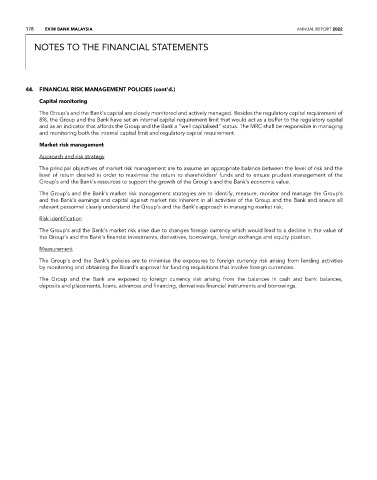Page 180 - EXIM-Bank_Annual-Report-2022
P. 180
178 eXIM BANK MALAYsIA ANNUAL REPORT 2022
Notes to the fiNaNcial statemeNts
44. FINaNCIaL RISk MaNaGEMENT POLICIES (cont’d.)
Capital monitoring
The Group’s and the Bank’s capital are closely monitored and actively managed. Besides the regulatory capital requirement of
8%, the Group and the Bank have set an internal capital requirement limit that would act as a buffer to the regulatory capital
and as an indicator that affords the Group and the Bank a “well capitalised” status. The MRC shall be responsible in managing
and monitoring both the internal capital limit and regulatory capital requirement.
Market risk management
Approach and risk strategy
The principal objectives of market risk management are to assume an appropriate balance between the level of risk and the
level of return desired in order to maximise the return to shareholders’ funds and to ensure prudent management of the
Group’s and the Bank’s resources to support the growth of the Group’s and the Bank’s economic value.
The Group’s and the Bank’s market risk management strategies are to identify, measure, monitor and manage the Group’s
and the Bank’s earnings and capital against market risk inherent in all activities of the Group and the Bank and ensure all
relevant personnel clearly understand the Group’s and the Bank’s approach in managing market risk.
Risk identification
The Group’s and the Bank’s market risk arise due to changes foreign currency which would lead to a decline in the value of
the Group’s and the Bank’s financial investments, derivatives, borrowings, foreign exchange and equity position.
Measurement
The Group’s and the Bank’s policies are to minimise the exposures to foreign currency risk arising from lending activities
by monitoring and obtaining the Board’s approval for funding requisitions that involve foreign currencies.
The Group and the Bank are exposed to foreign currency risk arising from the balances in cash and bank balances,
deposits and placements, loans, advances and financing, derivatives financial instruments and borrowings.

